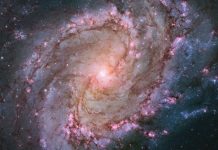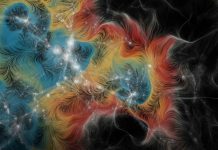
In the quest to understand the vastness of the universe, scientists have embarked on an ambitious project using a special tool called the Dark Energy Spectroscopic Instrument (DESI).
This incredible device is equipped with 5,000 tiny robots and is perched on a mountaintop telescope, peering into the depths of space to gather light from objects billions of years away.
This light, which has traveled across the universe to reach us, offers a glimpse into the cosmos as it was in its earliest stages, allowing scientists to trace how it has grown and changed over time.
One of the universe’s biggest puzzles is dark energy, a mysterious force thought to be causing the universe to expand. By studying how the universe has evolved, researchers hope to shed light on this enigma.
DESI represents a global effort, with over 800 scientists from various parts of the world coming together to work on this project. This team includes experts from the University of Rochester, who come from diverse fields such as physics, astronomy, data science, and computer science.
Together, they aim to measure 40 million galaxies and quasars, creating the most extensive 3D map of the universe ever made, which will provide unprecedented precision in our understanding of the cosmos.
This tool began its survey in 2021, and the first year’s data has already offered new insights into the universe’s expansion and its composition.
This initial batch of data is significantly larger than any previous collection, providing a much more detailed view of our universe’s early days and its rapid expansion.
DESI operates from the Mayall Telescope in Arizona, which has been upgraded to host this sophisticated instrument. Its 5,000 robotic optical fibers capture light from space, helping to map out the three-dimensional positions of galaxies and quasars.
This intricate setup enables scientists to explore the universe in ways that were not possible before.
The University of Rochester team has been instrumental in getting DESI up and running, from developing software to ensure accurate targeting to validating the data collected.
Their work helps ensure the reliability of the findings, crucial for understanding complex concepts like the universe’s expansion.
At the heart of DESI’s mission is the study of baryon acoustic oscillations (BAO), massive bubble-like structures in the universe formed shortly after the Big Bang. By analyzing these structures and how galaxies align within them, DESI can measure the universe’s expansion rate.
This expansion is believed to be driven by dark energy, a force that was discovered to be accelerating the universe’s expansion in 1999.
Theories suggest that invisible forces, or scalar fields, could be contributing to dark energy, similar to the Higgs field, known to scientists from previous research. DESI aims to explore whether there are more such fields and whether dark energy is constant throughout the universe or changes over time and space.
While initial findings support the idea of a constant dark energy, there are hints it might be an evolving force. However, more data is needed to confirm these fascinating possibilities, with the next significant update expected in late 2025.
This ongoing project represents a monumental step in our quest to understand the universe, its origins, and the mysterious forces that shape it.
Through the collective efforts of scientists around the world, tools like DESI are peeling back the layers of the cosmos, bringing us closer to answering some of physics’ most profound questions.
The research findings can be found here.
Copyright © 2024 Knowridge Science Report. All rights reserved.



